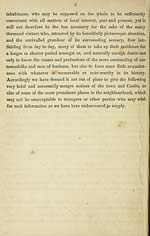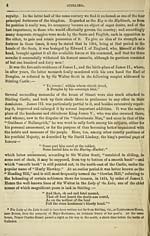Download files
Complete book:
Individual page:
Thumbnail gallery: Grid view | List view

STi RLI NG
Is generally understood to have derived its name from two Celtic words — consi-
derably changed, however, from their original form and sound — and signifying The
Hill of Strife. With this appellation its early history well accords, inasmuch as the
precipitous and commanding eminence, on the eastern slope of which the town Is
mainly built, together with the fields adjacent to it, have often, in days gone by, been
the scene of fierce and desperate conflict, on the. issues of which not unfrequently
depended the fate of fcicotland and of Scottish liberty. The town, which is a Eoyal
and Parliamentary Burgh, is situated 35 miles north-west from Edinburgh, which
city, by the way, it is said in some respects to resemble ; lies 28 miles north-east from
G-lasgow; and 33| miles south-west from Perth. It is the county town of the shire
to which it gives its name; and besides being the seat of a Sheriff, (having been
erected into a separate Sheriffdom by James IV.,) it is visited once in six months by
the Circuit Court of Justiciary. It is also one of five boroughs, known as the " Stir-
ing District of Boroughs," which unite in sending a representative to Parliament. It
was the chosen seat of royalty during several successive reigns of the Stuarts, when
the principal nobility of Scotland had also their residence there. But, after th©
removal of the Court, it gradually fell into decay, and for many years was little heard |i'
of save as a military station. Of late years, however, its trade has greatly revived,
through means of the opening up of railway communication betwixt it and all parts
of the country, and other favouring circumstances, so that the town and suburbs
have, within the last ten years or less, been much extended and improved. Ther©
are three weekly newspapers published in the town, as also two or three monthly
religious periodicals. The population at last census (1861) was 14,012, and classified
as follows, viz., 3250 families; 6814 males, 7198 females. The number of inhabited
the houses at the same period was 1433; uninhabited, 30; building, 11. During the
last few years, a large number of new houses and villas have been added.
STIELINa CASTLE.
The most conspicuous, and at the same time most interesting, object connected with
Stirling is its Castle. It stands on the western brow of the hill just referred to, at a
height of about 220 feet above the level of the surrounding plain, and commands, in
all directions, a far-reaching extent of country, which, for varied beauty and grandeur
of scenery, is rarely equalled, and scarce ever surpassed. It is, no doubt, to its Castle
that the town of Stirling has owed its origin ; but at what precise period the imposing
and warlike structure was first erected, it is now, we should say, very difficult, if not
impossible, to decide. Certain it is that Stirling, under the somewhat uncouth nama
of Stryveling^ occurs in authentic history so far back as the earlier part of the 12th
century, when, as would appear, from the circumstance of Alexander I., who
conferred on the town its royal charter, having died there in 1124, it must
in all probability have been at least the occasional, if not the ordinary abode of
Is generally understood to have derived its name from two Celtic words — consi-
derably changed, however, from their original form and sound — and signifying The
Hill of Strife. With this appellation its early history well accords, inasmuch as the
precipitous and commanding eminence, on the eastern slope of which the town Is
mainly built, together with the fields adjacent to it, have often, in days gone by, been
the scene of fierce and desperate conflict, on the. issues of which not unfrequently
depended the fate of fcicotland and of Scottish liberty. The town, which is a Eoyal
and Parliamentary Burgh, is situated 35 miles north-west from Edinburgh, which
city, by the way, it is said in some respects to resemble ; lies 28 miles north-east from
G-lasgow; and 33| miles south-west from Perth. It is the county town of the shire
to which it gives its name; and besides being the seat of a Sheriff, (having been
erected into a separate Sheriffdom by James IV.,) it is visited once in six months by
the Circuit Court of Justiciary. It is also one of five boroughs, known as the " Stir-
ing District of Boroughs," which unite in sending a representative to Parliament. It
was the chosen seat of royalty during several successive reigns of the Stuarts, when
the principal nobility of Scotland had also their residence there. But, after th©
removal of the Court, it gradually fell into decay, and for many years was little heard |i'
of save as a military station. Of late years, however, its trade has greatly revived,
through means of the opening up of railway communication betwixt it and all parts
of the country, and other favouring circumstances, so that the town and suburbs
have, within the last ten years or less, been much extended and improved. Ther©
are three weekly newspapers published in the town, as also two or three monthly
religious periodicals. The population at last census (1861) was 14,012, and classified
as follows, viz., 3250 families; 6814 males, 7198 females. The number of inhabited
the houses at the same period was 1433; uninhabited, 30; building, 11. During the
last few years, a large number of new houses and villas have been added.
STIELINa CASTLE.
The most conspicuous, and at the same time most interesting, object connected with
Stirling is its Castle. It stands on the western brow of the hill just referred to, at a
height of about 220 feet above the level of the surrounding plain, and commands, in
all directions, a far-reaching extent of country, which, for varied beauty and grandeur
of scenery, is rarely equalled, and scarce ever surpassed. It is, no doubt, to its Castle
that the town of Stirling has owed its origin ; but at what precise period the imposing
and warlike structure was first erected, it is now, we should say, very difficult, if not
impossible, to decide. Certain it is that Stirling, under the somewhat uncouth nama
of Stryveling^ occurs in authentic history so far back as the earlier part of the 12th
century, when, as would appear, from the circumstance of Alexander I., who
conferred on the town its royal charter, having died there in 1124, it must
in all probability have been at least the occasional, if not the ordinary abode of
Set display mode to: Large image | Transcription
Images and transcriptions on this page, including medium image downloads, may be used under the Creative Commons Attribution 4.0 International Licence unless otherwise stated. ![]()
| Scottish Post Office Directories > Towns > Stirling > Threepenny guide & directory for Stirling, Bridge of Allan, etc. > (11) |
|---|
| Permanent URL | https://digital.nls.uk/85270342 |
|---|
| Description | Directories of individual Scottish towns and their suburbs. |
|---|
| Description | Around 700 Scottish directories published annually by the Post Office or private publishers between 1773 and 1911. Most of Scotland covered, with a focus on Edinburgh, Glasgow, Dundee and Aberdeen. Most volumes include a general directory (A-Z by surname), street directory (A-Z by street) and trade directory (A-Z by trade). |
|---|


